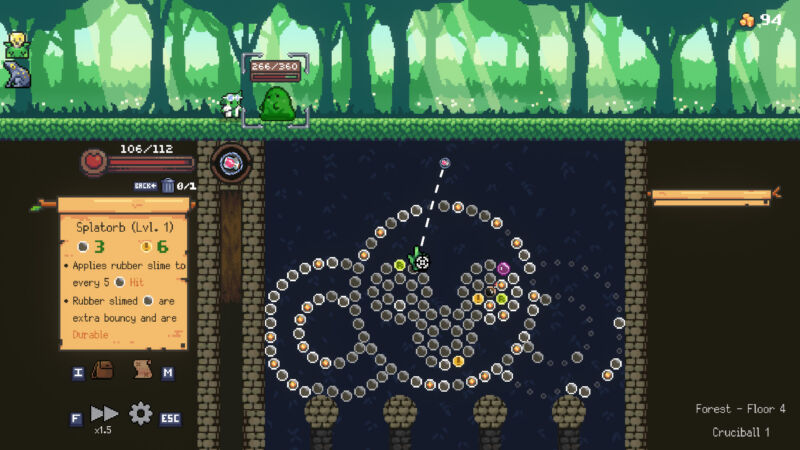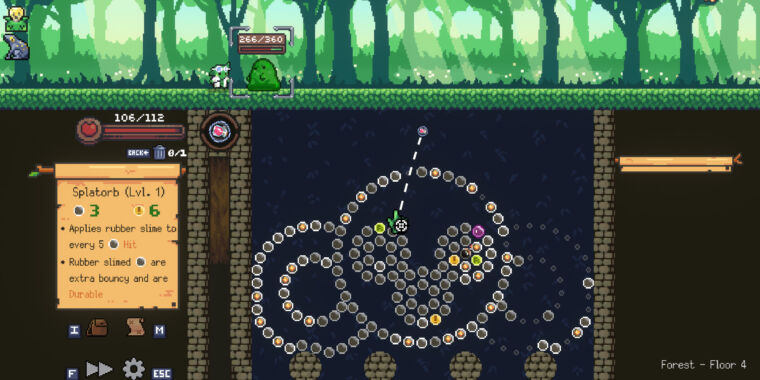
Red Nexus Games
Remember Peggle? If you were lucky enough to play this deceptively deep pachinko-meets-bagatelle game in the late ’00s, you know how addictive and entrancing it could be to just watch a bouncing ball ricochet off brightly colored pegs.
While developer Popcap released a few sequels and spinoffs in the years after Peggle‘s 2007 release, the series has largely languished since Popcap’s acquisition by EA in 2011. Today, the only actively supported version of the game is Peggle Blast, a smartphone port that dumbs down the gameplay with frequent pushes to spend real money on needed items, à la Candy Crush and its ilk.
A few other games have tried to capture the old Peggle ball-bouncing magic in the last decade, most notably the excellent but sometimes overwhelming Roundguard. But Peglin—which launched out of an extended Steam early access period and also saw a Nintendo Switch release this week—is my new favorite take on the concept, combining Peggle’s addictive ball-bouncing with just the right mix of roguelike randomization and RPG-style progression.
Take your shot
Every shot in Peglin is akin to a turn in an old-school RPG. Each peg your bouncing ball hits before falling out the bottom of the board contributes a bit to your attack power against a horde of enemies that slowly march toward you in a cute animated strip above.
-
Sliding your ball on patterns like this is one of the most satisfying parts of the game
Red Nexus Games -
You don’t always fire from the top of the board, which adds some fun angles to potential shots.
Red Nexus Games -
See if you can project where this ball will go just from this screenshot.
Red Nexus Games -
Getting your ball to consistently fall down the section you want in this situation is surprisingly difficult.
Red Nexus Games -
There’s some real artistry in some pegboard layouts.
Red Nexus Games
Not all pegs are created equal, though. Each board has two bright yellow “critical” pegs that crank up the attack value of each hit, moving randomly around the board between shots. Green “refresh” pegs are also needed to replace pegs that have disappeared after earlier hits and can lead to some extreme chains when hit at just the right point in a shot. Then there are the bombs, which send your ball flying after being lit and hit while also representing a powerful attack that hits all enemies.
The balls you fire aren’t all created equal, either. There are balls with extreme critical damage, balls that can impart harmful status effect on enemies, and balls that can coat pegs with helpful slime. There are balls that can heal your and balls that activate nearby pegs with each hit. Some balls are extra bouncy, others get attracted to each peg with a weak magnetic force, and still others get split into multiball patterns after being shot. You get the idea.
Building and upgrading a tailored bag of these varied and helpful balls—using coins collected from special pegs on each stage—is one of the most satisfying parts of a Peglin run. But those same coins are the best way of healing in between fights, so you have to manage your resources carefully. Runs can also be enhanced by a wide variety of powerful relics that give permanent stat bonuses or shot effects, though often with a downside that might outweigh the benefits if you’re not careful.
Each Peglin run progresses through a randomized Slay the Spire-style map, which lets you avoid a lot of battles if you’re careful. Amid the usual shops and treasures, you’ll also stumble on quite a few random encounters that let you make simple decisions like trading health for upgrades or risking existing balls for new, more powerful ones.

